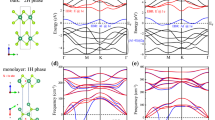Abstract
Progress in the field of superconductivity is often linked to the discovery of new classes of materials, with the layered copper oxides1 being a particularly impressive example. The superconductors known today include a wide spectrum of materials, ranging in complexity from simple elemental metals, to alloys and binary compounds of metals, to multi-component compounds of metals and chalcogens or metalloids, doped fullerenes and organic charge-transfer salts. Here we present a new class of superconductors: insulating organic molecular crystals that are made metallic through charge injection. The first examples are pentacene, tetracene and anthracene, the last having the highest transition temperature, at 4 K. We anticipate that many other organic molecular crystals can also be made superconducting by this method, which will lead to surprising findings in the vast composition space of molecular crystals.
This is a preview of subscription content, access via your institution
Access options
Subscribe to this journal
Receive 51 print issues and online access
$199.00 per year
only $3.90 per issue
Buy this article
- Purchase on Springer Link
- Instant access to full article PDF
Prices may be subject to local taxes which are calculated during checkout





Similar content being viewed by others
References
Bednorz, J. G. & Müller, K. A. Possible high Tc superconductivity in the Ba-La-Cu-O system. Z. Phys. B 64, 189–193 (1986).
Glover, R. E. & Sherill, M. D. Changes in superconducting critical temperature produced by electrostatic charging. Phys. Rev. Lett. 5, 248–250 ( 1960).
Mannhart, J., Ströbel, J., Bednorz, J. G. & Gerber, Ch. Large electric field effects in YBa2Cu3O7-δ films containing weak links. Appl. Phys. Lett. 62, 630–632 (1993).
Konsin, P. & Sorkin, B. Electric field effects in high T c cuprates. Phys. Rev. B 58, 5795– 5802 (1998).
Ahn, C. H. et al. Electrostatic modulation of superconductivity in ultrathin GdBa 2Cu3O7-x films. Science 284, 1152–1155 (1999).
Schön, J. H., Kloc, Ch., Haddon, R. C. & Batlogg, B. A superconducting field-effect switch. Science 288, 656– 658 (2000).
Schön, J. H., Berg, S., Kloc, Ch. & Batlogg, B. Ambipolar pentacene field-effect transistors and inverters. Science 287 , 1022–1023 (2000).
Silinsh, E. A. & Capek, V. Organic Molecular Crystals (AIP, New York, 1994).
Devos, A. & Lannoo, M. Electron-phonon coupling for aromatic molecular crystals: possible consequences for their superconductivity. Phys. Rev. B 58, 8236–8239 (1998).
Jerome, D., Mazaud, A., Ribault, M. & Beechgard, K. Superconductivity in a synthetic organic conductor (TMTSF)2PF6. J. Phys. Lett. 41, L95–L98 (1980).
Ishiguro, T., Yamaji, K. & Saito, G. Organic Superconductors (Springer, Berlin, 1998).
Warta, W. & Karl, N. Hot holes in naphtalene: High, electric-field dependent mobilities. Phys. Rev. B 32, 1172 –1182 (1985).
Warta, W., Stehle, R. & Karl, N. Ultrapure, high mobility organic photoconductors. Appl. Phys. A 36, 163–170 (1985).
Kivelson, S. & Chapman, O. L. Polyacene and a new class of quasi-one dimensional conductors. Phys. Rev. B 28, 7236–7243 (1983).
Mishima, A. & Kimura, M. Superconductivity of the quasi-one-dimensional semiconductor polyacene. Synth. Met. 11, 75–84 (1985).
Ginzburg, V. L. The problem of high temperature superconductivity. Contemp. Phys. 9, 355–374 ( 1968).
Kloc, Ch., Simpkins, P. G., Siegrist, T. & Laudise, R. A. Physical vapor growth of centimeter-sized crystals of α-hexathiophene. J. Cryst. Growth 182, 416– 427 (1997).
Schön, J. H., Kloc, Ch. & Batlogg, B. Fractional quantum Hall effect in organic molecular semiconductors. Science. 288, 2338– 2340 (2000).
Dodabalapur, A., Torsi, L. & Katz, H. E. Organic transistors: Two-dimensional transport and improved electrical characteristics. Science 268, 270–271 (1995).
Acknowledgements
We thank E. Bucher for use of equipment, and H. Y. Hwang, D. W. Murphy, H. Störmer and C. M. Varma for discussions. J.H.S. was supported by the Deutsche Forschungsgemeinschaft.
Author information
Authors and Affiliations
Corresponding author
Additional information
Several papers were recently the subject of an independent investigation conducted at the behest of Bell Laboratories, Lucent Technologies. The independent committee reviewed concerns related to the validity of data associated with the device measurements described in those papers. As a result of the committee's findings, we have issued retractions of those papers. Furthermore, because of the extensive and serious nature of the committee's findings relating to the manuscripts that they examined, we are additionally concerned about aspects of the data presented in this paper. As we cannot vouch for the validity of the data, we wish to withdraw our support for the paper and issue a retraction. The first author of this paper (J.H.S.), who was responsible for most of the experimental work, wishes to be dissociated from this retraction because he believes in the science presented in this manuscript.
About this article
Cite this article
Schön, J., Kloc, C. & Batlogg, B. RETRACTED ARTICLE: Superconductivity in molecular crystals induced by charge injection. Nature 406, 702–704 (2000). https://doi.org/10.1038/35021011
Received:
Accepted:
Published:
Issue Date:
DOI: https://doi.org/10.1038/35021011
This article is cited by
-
Electrochemically synthesized polymers in molecular imprinting for chemical sensing
Analytical and Bioanalytical Chemistry (2012)
-
Effects of carrier mobility on photocurrent generation in TiO2/poly(alkylthiophene) photovoltaic devices
Macromolecular Research (2006)
-
Growth dynamics of pentacene thin films
Nature (2001)
-
Superconductivity in single crystals of the fullerene C70
Nature (2001)
-
Gate-induced superconductivity in a solution-processed organic polymer film
Nature (2001)
Comments
By submitting a comment you agree to abide by our Terms and Community Guidelines. If you find something abusive or that does not comply with our terms or guidelines please flag it as inappropriate.



